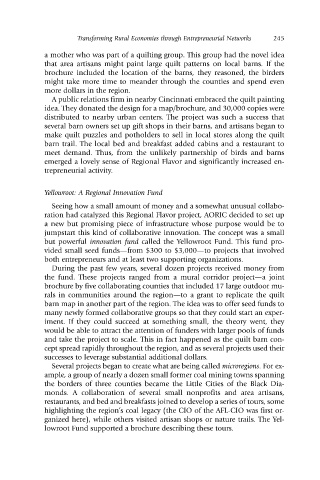Page 256 - 1-Entrepreneurship and Local Economic Development by Norman Walzer (z-lib.org)
P. 256
Transforming Rural Economies through Entrepreneurial Networks 245
a mother who was part of a quilting group. This group had the novel idea
that area artisans might paint large quilt patterns on local barns. If the
brochure included the location of the barns, they reasoned, the birders
might take more time to meander through the counties and spend even
more dollars in the region.
A public relations firm in nearby Cincinnati embraced the quilt painting
idea. They donated the design for a map/brochure, and 30,000 copies were
distributed to nearby urban centers. The project was such a success that
several barn owners set up gift shops in their barns, and artisans began to
make quilt puzzles and potholders to sell in local stores along the quilt
barn trail. The local bed and breakfast added cabins and a restaurant to
meet demand. Thus, from the unlikely partnership of birds and barns
emerged a lovely sense of Regional Flavor and significantly increased en-
trepreneurial activity.
Yellowroot: A Regional Innovation Fund
Seeing how a small amount of money and a somewhat unusual collabo-
ration had catalyzed this Regional Flavor project, AORIC decided to set up
a new but promising piece of infrastructure whose purpose would be to
jumpstart this kind of collaborative innovation. The concept was a small
but powerful innovation fund called the Yellowroot Fund. This fund pro-
vided small seed funds—from $300 to $3,000—to projects that involved
both entrepreneurs and at least two supporting organizations.
During the past few years, several dozen projects received money from
the fund. These projects ranged from a mural corridor project—a joint
brochure by five collaborating counties that included 17 large outdoor mu-
rals in communities around the region—to a grant to replicate the quilt
barn map in another part of the region. The idea was to offer seed funds to
many newly formed collaborative groups so that they could start an exper-
iment. If they could succeed at something small, the theory went, they
would be able to attract the attention of funders with larger pools of funds
and take the project to scale. This in fact happened as the quilt barn con-
cept spread rapidly throughout the region, and as several projects used their
successes to leverage substantial additional dollars.
Several projects began to create what are being called microregions. For ex-
ample, a group of nearly a dozen small former coal mining towns spanning
the borders of three counties became the Little Cities of the Black Dia-
monds. A collaboration of several small nonprofits and area artisans,
restaurants, and bed and breakfasts joined to develop a series of tours, some
highlighting the region’s coal legacy (the CIO of the AFL-CIO was first or-
ganized here), while others visited artisan shops or nature trails. The Yel-
lowroot Fund supported a brochure describing these tours.

